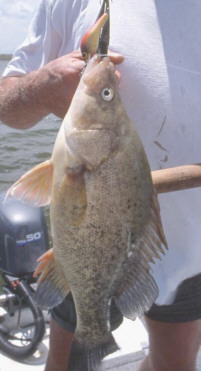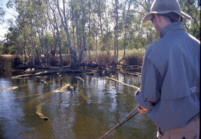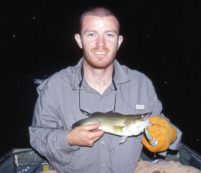As
the Murray River winds its way from the Victorian highlands,
its waters warm as they flow through the lowland plains. These
warmer farming areas of southern New South Wales and northern
Victoria require a steady supply of water to keep the crops
lush. To assist with this irrigation, two weirs were constructed
across the Murray River thus forming the grand lakes of Hume
and Mulwala.
These lakes provide good fishing and draw anglers from all over
the country for a shot at the abundant cod that make Mulwala
famous or those thumping Golden perch found in Lake Hume.
|
Lake
Hume - the ideal mixed fishery
Located at the foothills of the Victoria high plains adjacent
the twin towns of Albury and Wodonga, is Lake Hume. This
is a prime example of a productive 'mixed' fishery where
fish native to Australia and desirable imports such as
trout can co-exist to provide a productive year-round
fishery.
Both the trout and native fish thrive as the food, in
the form of forage fish, yabbies (small crayfish) and
insects are all prolific. During the cooler months, the
trout and English perch (redfin) are the main targets
and the natives come on the bite in the warmer half of
the year.
The
trout in Lake Hume can get to fantastic sizes and the
tailrace fishery under the weir is one of the better places
in Australia to target trophy trout that can approach
7kg in weight.
The local trout population can be caught using 'mudeye'
(dragonfly larvae) and worms (amongst other baits), but
it's the lure fishing below the weir wall that draws the
crowds during the cooler months (there is a closed season
for trout fishing during their spawning season in both
New South Wales and Victoria - please check local guides).
Driven by the urge to spawn, the large brown trout of
the Murray River head upstream and congregate under the
weir of Lake Hume. Anglers in the know are normally waiting
with lead lures known as 'lead-fish'. These heavy artificials
are lowered to the bottom and jigged back to the boat
through the deep, fast flowing water. This somewhat unconventional
method of trout angling has accounted for many trophy
brown trout over the years.
Another popular method is to walk the banks and cast deep
diving lures into the backwaters and eddies caused by
the fast flowing water.
This method is also particularly effective for targeting
golden perch in the warmer months.
During
the summer months, the water temperature rises to around
23-25 degrees and this sees the native fish come alive
around the rocky points and steep banks.
Trout can still be caught at dawn or by using downriggers
around the dam wall, as this is when and where the water
is coolest.
Golden perch have been recorded at around 7kg in Lake
Hume, which firmly cements it in the 'trophy waters' class
as far as 'GPs' are concerned.
Murray cod and silver perch are also present in Lake Hume,
but are nowhere near as prevalent as other species. They
can be caught using conventional baits such as the bardi
grub (for cod), worms or trolling deep-diving lures.
The redfin fishing in Lake Hume can really turn on a hot
bite now and again. 'Reddies' have many keen anglers chasing
this tasty European species during the summer months -
when they bite best.
These fish can be caught using jigs and drifting the deeper
(6-10m) sections of the lake, using baits and most minnow-style
lures around the shallows or many drowned trees.
|
|
|
|
Golden
perch love deep diving lures. This smaller model
grabbed a locally made lure cast at a rocky outcrop
in Lake Hume.
|
|
Mighty
Mulwala
Lake Mulwala is without a doubt the jewel in the crown of the
Murray River and a favourite destination of mine.
The lake is located on the NSW - Victorian boarder with the
towns of Yarrawonga and Mulwala at its shores.
Lake Mulwala's fish population consists almost entirely of native
fish, with a large population of carp and a lesser population
of redfin.
The average size of the cod in Lake Mulwala would be fairly
small at around 3-7kg, but there is a healthy population of
this sized fish.
Each
year fish in excess of 20kg are caught from this lake making
it one of Australia's premier naturally recruiting cod impoundments.
The golden perch here are becoming more prevalent thanks to
an ongoing stocking program.
Thousands of silver perch have been stocked into this lake,
but seem to evade capture party due to their migratory habits,
diet (being in direct competition with carp) and general tendency
to shy away from lures.
Due to Mulwala's extensive snag-riddled shallows, casting surface
lures and flies at dawn and dusk can really test out our heart!
Most cod caught this way are the smaller, more aggressive fish
from 30 to 60cm.
|
|
|
|
|
Check
out all those logs! Gav nervously eases a large spinnerbait
along the edge of a likely looking snag. Just about every
log has a cod under it at Mulwala - tempting them is another
thing! Shallow snaggy areas such as this are prime spots
for surface lures at dawn and dusk.
|
Yours
truly, with a decent 57cm cod taken slow rolling a large
spinnerbait amongst the logs at Mulwala.
|
Gav
Moloney shows how it's done with a lovely little cod taken
on a surface lure below the weir at Lake Mulwala. Most
surface strikes occur during low light conditions and
coincide with good insect activity - check out the bugs
around Gav's head!
|
Both
lakes are well catered for with boat ramps and caravan parks
around their shores.
The towns around the lakes also have many great places to eat
out and plenty of things to do which makes for a great family
destination.
The bird life around both lakes is both spectacular and varied
- well worth a trip for those avid bird watches and bush walkers.
Sunsets through the stands of drowned timber are equally spectacular
so don't forget the photography equipment either.
|
|
|
Both
lakes offer some stunning photo opportunities. The drowned
timber is also haven for the sport fish that inhabit the
lakes.
|
Hoo
roo!
Slates
Related
Topics:
Murray
River Introduction - Neil Slater
Murray
River Part 2. The Main Arterial - Neil Slater








